Conducting Silicone-Based Polymers and Their Application
Abstract
1. Introduction
2. Arylsilanes—The Most Commonly Used Syntheses
3. Siloles—The Most Commonly Used Syntheses
4. Application in Different Fields
4.1. Resins
4.2. Organic Solar Cells
4.3. Organic Light-Emitting Diodes
4.4. Organic Field-Effect Transistors
4.5. Silicone-Based Materials in Sensors and Biosensors
5. Conclusions
Author Contributions
Funding
Institutional Review Board Statement
Conflicts of Interest
References
- Arukalam, I.O.; Oguzie, E.E.; Li, Y. Nanostructured superhydrophobic polysiloxane coating for high barrier and anticorrosion applications in marine environment. J. Colloid Interface Sci. 2018, 512, 674–685. [Google Scholar] [CrossRef] [PubMed]
- Tang, X.; Yao, L.; Liu, H.; Shen, F.; Zhang, S.; Zhang, H.; Lu, P.; Ma, Y. An Efficient AIE-Active Blue-Emitting Molecule by Incorporating Multifunctional Groups into Tetraphenylsilane. Chem. Eur. J. 2014, 20, 7589–7592. [Google Scholar] [CrossRef] [PubMed]
- Shang, Y.; Zheng, N.; Wang, Z. Tetraphenylsilane-Cored Star-Shaped Polymer Micelles with pH/Redox Dual Response and Active Targeting Function for Drug-Controlled Release. Biomacromolecules 2019, 20, 4602–4610. [Google Scholar] [CrossRef]
- Ma, J.; Xia, W.; Zhang, R.; Ding, L.; Kong, Y.; Zhang, H.; Fu, K. Flocculation of emulsified oily wastewater by using functional grafting modified chitosan: The effect of cationic and hydrophobic structure. J. Hazard. Mater. 2021, 403, 123690. [Google Scholar] [CrossRef]
- Koda, S. Kinetic aspects of oxidation and combustion of silane and related compounds. Prog. Energy Combust. Sci. 1992, 18, 513–528. [Google Scholar] [CrossRef]
- Walsh, R. Bond dissociation energy values in silicon-containing compounds and some of their implications. Acc. Chem. Res. 1981, 14, 246–252. [Google Scholar] [CrossRef]
- Walsh, R. Thermochemistry of silicon-containing compounds. Part 1—Silicon–halogen compounds, an evaluation. J. Chem. Soc. Faraday Trans. 1 1983, 79, 2233–2248. [Google Scholar] [CrossRef]
- Semenov, V.V. Alkanes and silanes: Similarities and differences. Her. Russ. Acad. Sci. 2016, 86, 466–472. [Google Scholar] [CrossRef]
- Mark, J.E.; Allcock, H.R.; West, R. Inorganic Polymers, 2nd ed.; Oxford University Press: New York, NY, USA, 2004. [Google Scholar]
- Mark, J.E. Some Interesting Things about Polysiloxanes. Acc. Chem. Res. 2004, 37, 946–953. [Google Scholar] [CrossRef]
- Lee, S.H.; Jang, B.B.; Kafafi, Z.H. Highly Fluorescent Solid-State Asymmetric Spirosilabifluorene Derivatives. J. Am. Chem. Soc. 2005, 127, 9071–9078. [Google Scholar] [CrossRef]
- Ahmad, N.A.; Leo, C.P.; Ahmad, A.L. Amine wetting evaluation on hydrophobic silane modified polyvinylidene fluoride/silicoaluminophosphate zeolite membrane for membrane gas absorption. J. Nat. Gas. Sci. Eng. 2018, 58, 115–125. [Google Scholar] [CrossRef]
- Zaręba, J.K. Tetraphenylmethane and tetraphenylsilane as building units of coordination polymers and supramolecular networks—A focus on tetraphosphonates. Inorg. Chem. Commun. 2017, 86, 172–186. [Google Scholar] [CrossRef]
- Guan, W.W.; Shi, X.Y.; Xu, T.T.; Wan, K.; Zhang, B.W.; Liu, W.; Su, H.L.; Zou, Z.Q.; Du, Y.W. Synthesis of well-insulated Fe–Si–Al soft magnetic composites via a silane-assisted organic/inorganic composite coating route. J. Phys. Chem. Solids 2021, 150, 109841. [Google Scholar] [CrossRef]
- Bomina, S.; Honglae, S. 1,3,5-Trinitrotoluene Sensor Based on Silole Nanoaggregates. J. Nanosci. Nanotechnol. 2019, 19, 991–995. [Google Scholar] [CrossRef]
- Thames, S.F.; Panjnani, K.G. Organosilane polymer chemistry: A review. J. Inorg. Organomet. Polym. 1996, 6, 59–94. [Google Scholar] [CrossRef]
- Corey, J.Y. Siloles: Part 2: Silaindenes (Benzosiloles) and Silafluorenes (Dibenzosiloles): Synthesis, Characterization, and Applications. In Advances in Organometallic Chemistry; Hill, A.F., Fink, M.J., Eds.; Academic Press: Cambridge, MA, USA, 2011; Volume 59, pp. 181–328. [Google Scholar] [CrossRef]
- Chruściel, J.J.; Leśniak, E. Modification of epoxy resins with functional silanes, polysiloxanes, silsesquioxanes, silica and silicates. Prog. Polym. Sci. 2015, 41, 67–121. [Google Scholar] [CrossRef]
- Sasi Kumar, R.; Padmanathan, N.; Alagar, M. Design of hydrophobic polydimethylsiloxane and polybenzoxazine hybrids for interlayer low k dielectrics. New J. Chem. 2015, 39, 3995–4008. [Google Scholar] [CrossRef]
- Liu, H.; Fu, Z.; Song, F.; Qingquan, L.; Chen, L. The controllable construction and properties characterization of organic–inorganic hybrid materials based on benzoxazine-bridged polysilsesquioxanes. RSC Adv. 2017, 7, 3136–3144. [Google Scholar] [CrossRef]
- Hsieh, C.Y.; Su, W.C.; Wu, C.S.; Lin, L.K.; Hsu, K.Y.; Liu, Y.L. Benzoxazine-containing branched polysiloxanes: Highly efficient reactive-type flame retardants and property enhancement agents for polymers. Polymer 2013, 54, 2945–2951. [Google Scholar] [CrossRef]
- Feng, D.; Wang, K.; Wei, Z.; Chen, Y.-P.; Simon, C.M.; Arvapally, R.K.; Martin, R.L.; Bosch, M.; Liu, T.-F.; Fordham, S.; et al. Kinetically tuned dimensional augmentation as a versatile synthetic route towards robust metal-organic frameworks. Nat. Commun. 2014, 5, 5723. [Google Scholar] [CrossRef]
- Duncan, N.C.; Hay, B.P.; Hagaman, E.W.; Custelcean, R. Thermodynamic, Kinetic, and Structural Factors in the Synthesis of Imine-Linked Dynamic Covalent Frameworks. Tetrahedron 2012, 68, 53–64. [Google Scholar] [CrossRef]
- Rose, M.; Böhlmann, W.; Sabo, M.; Kaskel, S. Element–organic frameworks with high permanent porosity. Chem. Commun. 2008, 2462–2464. [Google Scholar] [CrossRef]
- Sun, D.; Zhou, X.; Li, H.; Sun, X.; Zheng, Y.; Ren, Z.; Ma, D.; Bryce, M.R.; Yan, S. A versatile hybrid polyphenylsilane host for highly efficient solution-processed blue and deep blue electrophosphorescence. J. Mater. Chem. C 2014, 2, 8277–8284. [Google Scholar] [CrossRef]
- Li, X.; Bai, Q.; Li, J.; Lu, F.; Sun, X.; Lu, P. Synthesis and properties of wide bandgap polymers based on tetraphenylsilane and their applications as hosts in electrophosphorescent devices. New J. Chem. 2018, 42, 3344–3349. [Google Scholar] [CrossRef]
- Moncada, J.; Terraza, C.A.; Tagle, L.H.; Coll, D.; Ortiz, P.; Pérez, G.; de la Campa, J.G.; Álvarez, C.; Tundidor-Camba, A. Synthesis, characterization and studies of properties of six polyimides derived from two new aromatic diamines containing a central silicon atom. Eur. Polym. J. 2017, 91, 354–367. [Google Scholar] [CrossRef]
- Tundidor-Camba, A.; González-Henríquez, C.M.; Sarabia-Vallejos, M.A.; Tagle, L.H.; Hauyón, R.A.; Sobarzo, P.A.; González, A.; Ortiz, P.A.; Maya, E.M.; Terraza, C.A. Silylated oligomeric poly(ether-azomethine)s from monomers containing biphenyl moieties: Synthesis and characterization. RSC Adv. 2018, 8, 1296–1312. [Google Scholar] [CrossRef]
- Cai, M.; Xiao, T.; Hellerich, E.; Chen, Y.; Shinar, R.; Shinar, J. High-Efficiency Solution-Processed Small Molecule Electrophosphorescent Organic Light-Emitting Diodes. Adv. Mater. 2011, 23, 3590–3596. [Google Scholar] [CrossRef]
- Oner, S.; Oner, I.; Akda, H.; Varlikli, G.C. Tetraphenylsilane group containing carbazoles as high triplet energy host materials for solution-processable PhOLEDs. Turk. J. Chem. 2015, 39, 917–929. [Google Scholar] [CrossRef]
- Arsenyan, P.; Pudova, O.; Popelis, J.; Lukevics, E. Novel radial oligothienyl silanes. Tetrahedron Lett. 2004, 45, 3109–3111. [Google Scholar] [CrossRef]
- Wang, Y.; Tan, D. Synthesis, thermal degradation and dielectric properties of poly[octyl(triphenylethynyl)]silane resin. Chem. Res. Chin. Univ. 2019, 35, 1076–1081. [Google Scholar] [CrossRef]
- Kai, Z.; Li, H.; Shi, H.; Wu, J.; Xu, J.; Li, Y.; Zhao, C. Synthesis and Thermal Properties of Silicon-Containing Benzoxazine. High Perform. Polym. 2020, 32, 59–64. [Google Scholar] [CrossRef]
- Zając, D.; Sołoducho, J.; Jarosz, T.; Łapkowski, M.; Roszak, S. Conjugated silane-based arylenes as luminescent materials. Electrochim. Acta 2015, 173, 105–116. [Google Scholar] [CrossRef]
- Zając, D.; Sołoducho, J.; Jarosz, T.; Łapkowski, M.; Roszak, S. Push-pull structures of symmetric silane derivatives as a novel hosting materials. Indian J. Appl. Res. 2017, 7, 58–66. [Google Scholar]
- Yang, R.; Li, D.; Bai, Y.; Zhang, L.; Liu, Z.; Hao, J.; Wei, Q.; Liao, L.; Peng, R.; Ge, Z. Novel tetraarylsilane-based hosts for blue phosphorescent organic light-emitting diodes. Org. Electron. 2018, 55, 117–125. [Google Scholar] [CrossRef]
- Bezvikonnyi, O.; Grybauskaite-Kaminskiene, G.; Volyniuk, D.; Simokaitiene, J.; Danyliv, Y.; Durgaryan, R.; Bucinskas, A.; Jatautienė, E.; Hladka, I.; Scholz, J.; et al. 3,3′-Bicarbazole-based compounds as bipolar hosts for green and red phosphorescent organic light-emitting devices. Mater. Sci. Eng. B 2020, 261, 114662. [Google Scholar] [CrossRef]
- Junjie, H.; Hu, Y.; Deng, S.F.; Zhou, J.L.; Jiang, N.; Zhu, Y.; Sun, M. Synthesis and Properties of a Novel Silicon-Containing Phthalonitrile Resin and Its Quartz-Fiber-Reinforced Composites. High Perform. Polym. 2020, 32, 1112–1121. [Google Scholar] [CrossRef]
- Tagle, L.H.; Terraza, C.; Tundidor-Camba, A.; Coll, D. Silicon-containing poly(esters) with halogenated bulky side groups. Synthesis, characterization and thermal studies. RSC Adv. 2015, 5, 49132–49142. [Google Scholar] [CrossRef]
- Ma, M.; Gong, C.; Li, C.; Yuan, Q.; Huang, F. The synthesis and properties of silicon-containing arylacetylene resins with rigid-rod 2,5-diphenyl-[1,3,4]-oxadiazole moieties. Eur. Polym. J. 2021, 143, 110192. [Google Scholar] [CrossRef]
- Milenin, S.A.; Ardabevskaia, S.N.; Novikov, R.A.; Solyev, P.N.; Tkachev, Y.V.; Volodin, A.D.; Korlyukov, A.A.; Muzafarov, A.M. Construction of siloxane structures with P-Tolyl substituents at the silicon atom. J. Organomet. Chem. 2020, 926, 121497. [Google Scholar] [CrossRef]
- Makhmudiyarova, N.N.; Ishmukhametova, I.R.; Ibragimov, A.G. Lanthanide-Catalyzed Synthesis of Cyclic Silicon-Containing Di- and Triperoxides. Russ. J. Org. Chem. 2020, 56, 1685–1690. [Google Scholar] [CrossRef]
- Kim, D.H.; Ohshita, J.; Lee, K.H.; Kunugi, Y.; Kunai, A. Synthesis of π-Conjugated Oligomers Containing Dithienole Units. Organometallics 2006, 25, 1511–1516. [Google Scholar] [CrossRef]
- Grisorio, R.; Suranna, G.P.; Mastrorilli, P.; Allegretta, G.; Loiudice, A.; Rizzo, A.; Gigli, G.; Manoli, K.; Magliulo, M.; Torsi, L. All-donor poly(arylene-ethynylene)s containing anthracene and silole-based units: Synthesis, electronic, and photovoltaic properties. J. Polym. Sci. Part A Polym. Chem. 2013, 51, 4860–4872. [Google Scholar] [CrossRef]
- Chen, J.; Xie, Z.; Lam, J.W.Y.; Law, C.C.W.; Tang, B.Z. Silole-Containing Polyacetylenes. Synthesis, Thermal Stability, Light Emission, Nanodimensional Aggregation, and Restricted Intramolecular Rotation. Macromolecules 2003, 36, 1108–1117. [Google Scholar] [CrossRef]
- Zając, D.; Honisz, D.; Łapkowski, M.; Sołoducho, J. Synthesis and Properties of New Dithienosilole Derivatives as Luminescent Materials. Molecules 2019, 24, 2259. [Google Scholar] [CrossRef]
- Feng, Y.; Dai, C.; Lei, J.; Ju, H.; Cheng, Y. Silole-Containing Polymer Nanodot: An Aqueous Low-Potential Electrochemiluminescence Emitter for Biosensing. Anal. Chem. 2016, 88, 845–850. [Google Scholar] [CrossRef]
- Horst, S.; Evans, N.R.; Bronstein, H.A.; Williams, C.K. Synthesis of fluoro-substituted silole-containing conjugated materials. J. Polym. Sci. A Polym. Chem. 2009, 47, 5116–5125. [Google Scholar] [CrossRef]
- Pöcheim, A.; Özpınar, G.A.; Müller, T.; Baumgartner, J.; Marschner, C. The Combination of Cross-Hyperconjugation and σ-Conjugation in 2,5-Oligosilanyl Substituted Siloles. Chem. Eur. J. 2020, 26, 17252–17260. [Google Scholar] [CrossRef] [PubMed]
- Cai, Y.; Samedov, K.; Dolinar, B.S.; Song, Z.; Tang, B.Z.; Zhang, C.; West, R. Synthesis and High Solid-State Fluorescence of Cyclic Silole Derivatives. Organometallics 2015, 34, 78–85. [Google Scholar] [CrossRef]
- Chuantao, G.; Chunying, Z.; Bing, L.; Tingyu, F.; Jiping, M.; Haofen, S. Synthesis of a dithieno[3,2-b:2′,3′-d]silole-based conjugated polymer and characterization of its short wave near-infrared fluorescence properties. J. Innov. Opt. Health Sci. 2020, 13, 2041002. [Google Scholar] [CrossRef]
- Yang, L.; Koo, D.; Wu, J.; Wong, J.M.; Day, T.; Zhang, R.; Kolongoda, H.; Liu, K.; Wang, J.; Ding, Z.; et al. Benzosiloles with Crystallization-Induced Emission Enhancement of Electrochemiluminescence: Synthesis, Electrochemistry, and Crystallography. Chem. Eur. J. 2020, 26, 11715–11721. [Google Scholar] [CrossRef]
- Ruiqi, C.; Liqing, A.; Hongxia, Y.; Shuhong, L.; Caihong, X. Aggregation-tuned dual emission of silole derivatives: Synthesis, crystal structure, and photophysical properties. New J. Chem. 2020, 44, 5049–5055. [Google Scholar] [CrossRef]
- Scott, C.N.; Bisen, M.D. Synthesis of reactively functionalized 2,5-siloles using kumada-type nickel-mediated intramolecular cyclization and their utilization in polymer synthesis. Polymer 2019, 170, 204–210. [Google Scholar] [CrossRef]
- Fan, S.; Zhu, C.; Wu, D.; Wang, X.; Yu, J.; Li, F. Silicon-containing inherent flame-retardant polyamide 6 with anti-dripping via introducing ethylene glycol as the chain-linker and charring agent. Polym. Degrad. Stab. 2020, 173, 109080. [Google Scholar] [CrossRef]
- Yuan, D.; Yin, H.; Cai, X. Synergistic effects between silicon-containing flame retardant and potassium-4-(phenylsulfonyl)benzenesulfonate (KSS) on flame retardancy and thermal degradation of PC. J. Therm. Anal. Calorim. 2012, 114, 19–25. [Google Scholar] [CrossRef]
- Liu, L.; Zhang, L.; Li, M.; Guo, Y.; Song, J.; Wang, H. Random dithienosilole-based terpolymers: Synthesis and application in polymer solar cells. Dyes Pigment. 2016, 130, 63–69. [Google Scholar] [CrossRef]
- Chena, X.; Sunb, Y.; Wanga, Z.; Gaob, H.; Lina, Z.; Keb, X.; Hea, T.; Yina, S.; Chenb, Y.; Zhanga, Q.; et al. Dithienosilole-based small molecule donors for efficient all-small-moleculeorganic solar cells. Dyes Pigment. 2018, 158, 445–450. [Google Scholar] [CrossRef]
- Zhou, H.; Zhang, Y.; Mai, C.K.; Collins, S.D.; Bazan, G.C.; Nguyen, T.Q.; Heeger, A.J. Polymer homo-tandem solar cells with best efficiency of 11.3%. Adv. Mater. 2015, 27, 1767–1773. [Google Scholar] [CrossRef]
- Zhang, J.; Zhang, Y.; Fang, J.; Lu, K.; Wang, Z.; Ma, W.; Wei, Z. Conjugated polymer-small molecule alloy leads to high efficient ternary organic solar cells. J. Am. Chem. Soc. 2015, 137, 8176–8183. [Google Scholar] [CrossRef]
- You, J.; Dou, L.; Yoshimura, K.; Kato, T.; Ohya, K.; Moriarty, T.; Emery, K.; Chen, C.-C.; Gao, J.; Li, G.; et al. A polymer tandem solar cell with 10.6% power conversion efficiency. Nat. Commun. 2013, 4, 1446. [Google Scholar] [CrossRef]
- Li, Y. Molecular design of photovoltaic materials for polymer solar cells: Electronic energy levels and broad absorption. Acc. Chem. Res. 2012, 45, 723–733. [Google Scholar] [CrossRef]
- Xia, B.; Lu, K.; Yuan, L.; Zhang, J.; Zhu, L.; Zhu, X.; Deng, D.; Li, H.; Wei, Z. A conformational locking strategy in linked-acceptor type polymers for organic solar cells. Polym. Chem. 2016, 7, 1323. [Google Scholar] [CrossRef]
- Zhao, Y.; Zhang, L.; Liu, S.; Yang, C.; Yi, J.; Yang, C. Thieno [3,2-b]thiophene-Bridged Conjugated Polymers Based on Dithieno [3,2-b:2′,3′-d] silole and Thieno m[3¨C-c]pyrrole-4,6-dione for Polymer Solar Cells: Influence of Side Chains on Optoelectronic Properties. Macromol. Chem. Phys. 2018, 219, 1800297. [Google Scholar] [CrossRef]
- Song, J.S.; Du, C.; Li, C.H.; Bo, Z.S. Silole-containing polymers for high-efficiency polymer solar cells. J. Polym. Sci. Pol. Chem. 2011, 49, 4267–4274. [Google Scholar] [CrossRef]
- Beaujuge, P.M.; Pisula, W.; Tsao, H.N.; Ellinger, S.; Mullen, K.; Reynolds, J.R. Tailoring structure-property relationships in dithienosilole-benzothiadiazole donoracceptor copolymers. J. Am. Chem. Soc. 2009, 131, 7514. [Google Scholar] [CrossRef]
- Li, M.; Liu, L.; Zhao, C.; Zhou, Y.; Guo, Y.; Song, J.; Wang, H. Side chain engineering of dithienosilole-based polymers for application in polymer solar cells. Dyes Pigment. 2016, 134, 480–486. [Google Scholar] [CrossRef]
- Chen, X.; Feng, H.; Lin, Z.; Jiang, Z.; He, T.; Yin, S.; Wan, X.; Chen, Y.; Zhang, Q.; Qiu, H. Impact of end-capped groups on the properties of dithienosilole-based small molecules for solution-processed organic solar cells. Dyes Pigment. 2017, 147, 183–189. [Google Scholar] [CrossRef]
- Ni, W.; Li, M.; Liu, F.; Wan, X.; Feng, H.; Kan, B.; Zhang, Q.; Zhang, H.; Chen, Y. Dithienosilole-Based Small-Molecule Organic Solar Cells with an Efficiency over 8%: Investigation of the Relationship between the Molecular Structure and Photovoltaic Performance. Chem. Mater. 2015, 27, 6077–6084. [Google Scholar] [CrossRef]
- Heo, H.; Kim, H.; Nam, G.; Lee, D.; Lee, Y. Multi-Donor Random Terpolymers Based on Benzodithiophene and Dithienosilole Segments with Different Monomer Compositions for High-Performance Polymer Solar Cells. Macromol. Res. 2018, 26, 238–245. [Google Scholar] [CrossRef]
- Nie, H.; Chen, B.; Zeng, J.; Xiong, Y.; Zhao, Z.; Tang, B.Z. Excellent n-type light emitters based on AIE-active silole derivatives for efficient simplified organic light-emitting diodes. J. Mater. Chem. C 2018, 6, 3690–3698. [Google Scholar] [CrossRef]
- Jou, J.H.; Kumar, S.; Agrawal, A.; Li, T.H.; Sahoo, S. Approaches for fabricating high efficiency organic light emitting diodes. J. Mater. Chem. C 2015, 3, 2974–3002. [Google Scholar] [CrossRef]
- Furue, R.; Nishimoto, T.; Park, I.S.; Lee, J.; Yasuda, T. Angew, Aggregation-Induced Delayed Fluorescence Based on Donor/Acceptor-Tethered Janus Carborane Triads: Unique Photophysical Properties of Nondoped OLEDs. Chem. Int. Ed. 2016, 55, 7171. [Google Scholar] [CrossRef]
- Cai, Y.; Qin, A.; Tang, B.Z. Siloles in optoelectronic devices. J. Mater. Chem. C 2017, 5, 7375–7389. [Google Scholar] [CrossRef]
- Cai, Y.; Samedov, K.; Dolinar, B.S.; Albright, H.; Song, Z.; Zhang, C.; Tang, B.Z.; West, R. AEE-active cyclic tetraphenylsilole derivatives with ∼100% solid-state fluorescence quantum efficiency. Dalton Trans. 2015, 44, 12970. [Google Scholar] [CrossRef] [PubMed]
- Dou, D.; You, J.; Hong, Z.; Xu, Z.; Li, G.; Street, R.A.; Yang, Y. 25th anniversary article: A decade of organic/polymeric photovoltaic research. Adv. Mater. 2013, 25, 6642–6671. [Google Scholar] [CrossRef] [PubMed]
- Zhao, W.; Li, S.; Yao, H.; Zhang, S.; Zhan, Y.; Yang, B.; Hou, J. Molecular Optimization Enables over 13% Efficiency in Organic Solar Cells. Am. Chem. Soc. 2017, 139, 7148–7151. [Google Scholar] [CrossRef] [PubMed]
- Park, H.; Rao, Y.; Varlan, M.; Kim, J.; Ko, S.B.; Wang, S.; Kang, Y. Synthesis and characterization of fluorene and carbazole dithienosilole derivatives for potential applications in organic light-emitting diodes. Tetrahedron 2012, 68, 9278–9283. [Google Scholar] [CrossRef]
- Xiong, Y.; Zeng, J.; Chen, B.; Lam, J.W.Y.; Zhao, Z.; Chen, S.; Tang, B.Z. New carbazole-substituted siloles for the fabrication of efficient non-doped OLEDs. Chin. Chem. Lett. 2019, 30, 592. [Google Scholar] [CrossRef]
- Chen, B.; Jiang, Y.; Chen, L.; Nie, H.; He, B.; Lu, P.; Sung, H.H.Y.; Williams, I.D.; Kwok, H.S.; Qin, A.; et al. 2,5-Difluorenyl-Substituted Siloles for the Fabrication of High-Performance Yellow Organic Light-Emitting Diodes. Chem. Eur. J. 2014, 20, 1931–1939. [Google Scholar] [CrossRef]
- Ju, M.; Wang, J.; Sun, J.Z.; Zhao, H.; Yuan, W.; Deng, C.; Chen, S.; Sung, H.H.Y.; Lu, P.; Qin, A.; et al. Siloles symmetrically substituted on their 2,5-positions with electron-accepting and donating moieties: Facile synthesis, aggregation-enhanced emission, solvatochromism, and device application. Chem. Sci. 2012, 3, 549–558. [Google Scholar] [CrossRef]
- Chen, B.; Jiang, Y.; He, B.; Zhou, J.; Sung, H.H.Y.; Williams, I.D.; Lu, P.; Kwok, H.S.; Qiu, H.; Zhao, Z.; et al. Synthesis, Structure, Photoluminescence, and Electroluminescence of Siloles that Contain Planar Fluorescent Chromophores. Chem. Asian J. 2014, 9, 2937–2945. [Google Scholar] [CrossRef]
- Zhang, H.; Yang, K.; Zhang, K.; Zhang, Z.; Sun, Q.; Yang, W. Thionating Iso-diketopyrrolopyrrole-based Polymers: From P-type to Ambipolar Field Effect Transistors with Enhanced Charge Mobility. Polym. Chem. 2018, 9, 1807–1814. [Google Scholar] [CrossRef]
- Zhang, H.; Deng, R.; Wang, J.; Li, X.; Chen, Y.M.; Liu, K.; Taubert, C.J.; Cheng, S.Z.; Zhu, Y. Crystalline Organic Pigment-Based Field-Effect Transistors. ACS Appl. Mater. Interfaces 2017, 9, 21891–21899. [Google Scholar] [CrossRef]
- Wang, Y.; Nakano, M.; Michinobu, T.; Kiyota, Y.; Mori, T.; Takimiya, K. Naphthodithiophenediimide–Benzobisthiadiazole-Based Polymers: Versatile n-Type Materials for Field-Effect Transistors and Thermoelectric Devices. Macromolecules 2017, 50, 857–864. [Google Scholar] [CrossRef]
- Kim, K.; Jeon, J.; Ha, Y.H.; Cha, H.; Park, C.E.; Kang, M.; Jhon, H.; Kwon, S.K.; Kim, Y.H.; An, T.K. Ambipolar charge transport of diketopyrrolepyrrole-silole-based copolymers and effect of side chain engineering: Compact model parameter extraction strategy for high-voltage logic applications. Org. Electron. 2018, 54, 1–8. [Google Scholar] [CrossRef]
- Lee, J.; Han, A.R.; Yu, H.; Shin, T.J.; Yang, C.; Oh, B.H. Boosting the ambipolar performance of solution-processable polymer semiconductors via hybrid side-chain engineering. J. Am. Chem. Soc. 2013, 135, 9540–9547. [Google Scholar] [CrossRef]
- Hu, J.Y.; Nakano, M.; Osaka, I.; Takimiya, K. Naphthodithiophenediimide (NDTI)-based triads for high-performance air-stable, solution-processed ambipolar organic field-effect transistors. J. Mater. Chem. C 2015, 3, 4244–4249. [Google Scholar] [CrossRef]
- Pao, Y.C.; Yang, C.T.; Lai, Y.Y.; Huang, W.C.; Hsu, C.S.; Cheng, Y.J. Synthesis and Field-Effect Transistor Properties of a Diseleno[3,2-b:2′3′-d]silole-Based Donor-Acceptor Copolymer: Investigation of Chalcogen Effect. Polym. Chem. 2016, 7, 4654–4660. [Google Scholar] [CrossRef]
- Kang, W.; Jung, M.; Cha, W.; Jang, S.; Yoon, Y.; Kim, H.; Son, H.J.; Lee, D.-K.; Kim, B.; Cho, J.H. High Crystalline Dithienosilole-Cored Small Molecule Semiconductor for Ambipolar Transistor and Nonvolatile Memory. ACS Appl. Mater. Interfaces 2014, 6, 6589–6597. [Google Scholar] [CrossRef]
- Barnett, N.W.; Hindson, B.J.; Lewis, S.W. Determination of 5-hydroxytryptamine (serotonin) and related indoles by flow injection analysis with acidic potassium permanganate chemiluminescence detection. Anal. Chim. Acta 1998, 362, 131–139. [Google Scholar] [CrossRef]
- Ngoepe, M.; Choonara, Y.E.; Tygai, C.; Tomar, L.K.; du Toit, L.C.; Kumar, P.; Ndesendo, V.M.K.; Pillay, V. Integration of Biosensors and Drug Delivery Technologies for Early Detection and Chronic Management of Illness. Sensors 2013, 13, 7680–7713. [Google Scholar] [CrossRef] [PubMed]
- Gokoglan, T.C.; Soylemez, S.; Kesik, M.; Toksabay, S.; Toppare, L. Selenium containing conducting polymer based pyranose oxidase biosensor for glucose detection. Food Chem. 2015, 172, 219. [Google Scholar] [CrossRef]
- De Taxi du Poet, P.; Miyamoto, S.; Murakami, T.; Kiura, J.; Karube, I. Direct electron transfer with glucose oxidase immobilized in an electropolymerized poly(N-methylpyrrole) film on a gold microelectrode. Anal. Chim. Acta 1990, 235, 255–264. [Google Scholar] [CrossRef]
- Han, X.; Wang, Z.; Cheng, Q. Mitochondria-dependent benzothiadiazole-based molecule probe for quantitatively intracellular pH imaging. Dyes Pigment. 2017, 145, 576–583. [Google Scholar] [CrossRef]
- Liang, L.; Liming, D. Photovoltaic-Active Dithienosilole-Containing Polymers. Macromolecules 2007, 40, 9406–9412. [Google Scholar] [CrossRef]
- Cordes, M.; Giese, B. Electron transfer in peptides and proteins. Chem. Soc. Rev. 2009, 38, 892–901. [Google Scholar] [CrossRef] [PubMed]
- Davies, R.P.; Less, R.; Lickiss, P.D.; Robertson, K.; White, A.J.P. Structural Diversity in Metal−Organic Frameworks Built from Rigid Tetrahedral [Si(p-C6H4CO2)4]4− Struts. Cryst. Growth Des. 2010, 10, 4571–4581. [Google Scholar] [CrossRef]
- Ren, X.; Li, J.; Holmes, R.J.; Djurovich, P.I.; Forrest, S.R.; Thompson, M.E. Ultrahigh energy gap hosts in deep blue organic electrophosphorescent devices. Chem. Mater. 2016, 16, 4743–4747. [Google Scholar] [CrossRef]
- Gong, S.; Chen, Y.; Yang, C.; Zhong, C.; Qin, J.; Ma, D. De Novo Design of Silicon-Bridged Molecule Towards a Bipolar Host: All-Phosphor White Organic Light-Emitting Devices Exhibiting High Efficiency and Low Efficiency Roll-Off. Adv. Mater. 2010, 22, 5370–5373. [Google Scholar] [CrossRef]
- Kwak, G.; Masuda, T. Poly(silyleneethynylenephenylene) and Poly(silylenephenyleneethynylenephenylene)s: Synthesis and Photophysical Properties Related to Charge Transfer. Macromolecules 2002, 10, 4138–4142. [Google Scholar] [CrossRef]
- Lee, C.W.; Lee, J.Y. Comparison of Tetraphenylmethane and Tetraphenylsilane as Core Structures of High-Triplet-Energy Hole- and Electron-Transport Materials. Chem. Eur. J. 2012, 18, 6457–6461. [Google Scholar] [CrossRef]
- Tang, X.; Yao, L.; Liu, H.; Shen, F.; Zhang, S.; Zhang, Y.; Zhang, H.; Lu, P.; Ma, Y. Novel violet emitting material synthesized by stepwise chemical reactions. J. Mater. Chem. 2014, 2, 5019–5027. [Google Scholar] [CrossRef]
- Hu, D.; Shen, F.; Liu, H.; Lu, P.; Liu, D.; Ma, Y. Separation of electrical and optical energy gaps for constructing bipolar organic wide bandgap materials. Chem. Commun. 2012, 48, 3015–3017. [Google Scholar] [CrossRef]
- Shang, Y.; Guo, L.; Wang, Z. Tetraphenylsilane-Cored Star-Shaped Amphiphilic Block Copolymers for pH-Responsive Anticancer Drug Delivery. Macromol. Chem. Phys. 2019, 220, 1900248. [Google Scholar] [CrossRef]
- Baluta, S.; Malecha, K.; Zając, D.; Sołoducho, J.; Cabaj, J. Dopamine sensing with fluorescence strategy based on low temperature co-fired ceramic technology modified with conducting polymers. Sens. Actuators B 2017, 252, 803–812. [Google Scholar] [CrossRef]
- Malecha, K. The Implementation of Fluorescence-Based Detection in LTCC (Low-Temperature-Co-Fired-Ceramics) Microfluidic Modules. Int. J. Appl. Ceram. Technol. 2015, 13, 69–77. [Google Scholar] [CrossRef]
- Baluta, S.; Zając, D.; Szyszka, A.; Malecha, K.; Cabaj, J. Enzymatic platforms for sensitive neurotransmitter detection. Sensors 2020, 20, 423. [Google Scholar] [CrossRef]
- Ulman, A. Formation and Structure of Self-Assembled Monolayers. Chem. Rev. 1996, 96, 1533–1554. [Google Scholar] [CrossRef]
- Xia, Y.; Whitesides, G.M. Soft Lithography. Angew. Chem. Int. Ed. 1998, 37, 550–575. [Google Scholar] [CrossRef]
- Schreiber, F. Structure and growth of self-assembling monolayers. Prog. Surf. Sci. 2000, 65, 151–257. [Google Scholar] [CrossRef]
- Zhong, X.; Yuan, R.; Chai, Y.; Liu, Y.; Dai, J.; Tang, D. Glucose biosensor based on self-assembled gold nanoparticles and double-layer 2d-network (3-mercaptopropyl)-trimethoxysilane polymer onto gold substrate. Sens. Actuators B 2005, 104, 191–198. [Google Scholar] [CrossRef]
- Hoffmann, C.; Tovar, G.E.M. Mixed self-assembled monolayers (SAMs) consisting of methoxy-tri(ethylene glycol)-terminated and alkyl-terminated dimethylchlorosilanes control the non-specific adsorption of proteins at oxidic surfaces. J. Colloid Interface Sci. 2006, 295, 427–435. [Google Scholar] [CrossRef]
- Dugas, V.; Demesmay, C.; Chevolot, Y.; Souteyrand, E. Use of Organosilanes in Biosensors; Nova Science Publishing Inc.: New York, NY, USA, 2010. [Google Scholar]
- Corrie, S.R.; Vogel, R.; Keen, I.; Jack, K.; Kozak, D.; Lawrie, G.A.; Battersby, B.; Fredericks Trau, M. A structural study of hybrid organosilica materials for colloid-based DNA biosensors. J. Mater. Chem. 2008, 18, 523–529. [Google Scholar] [CrossRef]
- Corso, C.D.; Dickherber, A.; Hunt, W.D. An investigation of antibody immobilization methods employing organosilanes on planar ZnO surfaces for biosensor applications. Biosens. Bioelectron. 2008, 24, 805–811. [Google Scholar] [CrossRef]
- Rand, E.; Periyakaruppan, A.; Tanaka, Z.; Zhang, D.A.; Marsh, M.P.; Andrews, R.J.; Lee, K.H.; Chen, B.; Meyyappan, M.; Koehne, J.E. A carbon nanofiber based biosensor for simultaneous detection of dopaminę and serotonin in the presence of ascorbic acid. Biosens. Bioelectron. 2013, 42, 434–438. [Google Scholar] [CrossRef]
- Ran, G.; Chen, X.; Xia, Y. Electrochemical detection of serotonin based on a poly (bromocresol green) film and Fe3O4 nanoparticles in a chitosan matrix. RSC Adv. 2017, 7, 1847–1851. [Google Scholar] [CrossRef]
- Dinesh, B.; Veeramani, V.; Chen, S.M.; Saraswathi, R. In situ electrochemical synthesis of reduced Graphene oxide-cobalt oxide nanocomposite modified electrode for selective sensing of depression biomarker in the presence of ascorbic acid and dopamine. J. Electroanal. Chem. 2017, 786, 169–176. [Google Scholar] [CrossRef]
- Young, L.; Lin, D.; Huang, J.; You, T. Simultaneous determination of dopamine, ascorbic acid and uric acid at electrochemically reduced graphene oxide modified electrode. Sens. Actuators B 2014, 193, 166–172. [Google Scholar] [CrossRef]
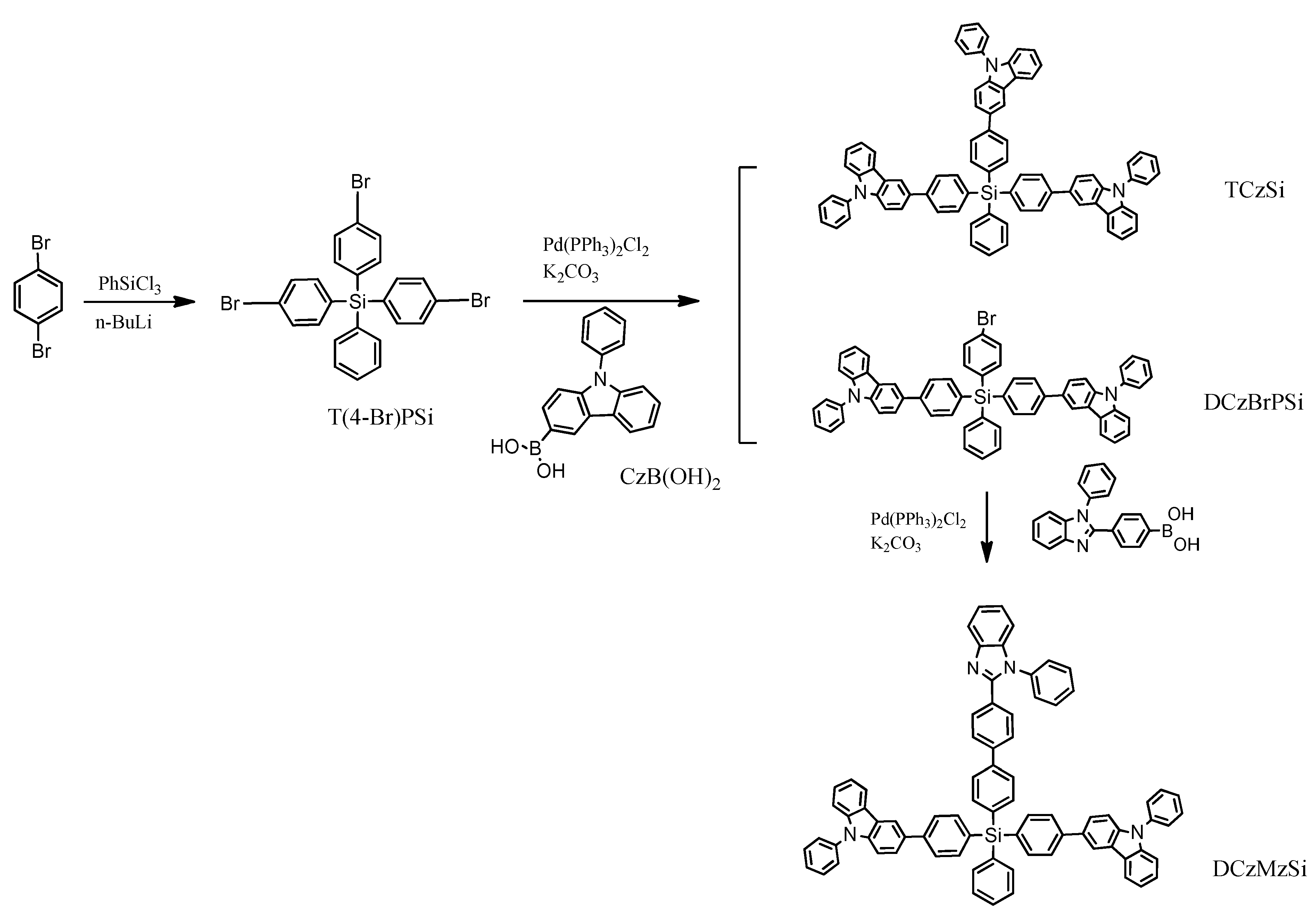



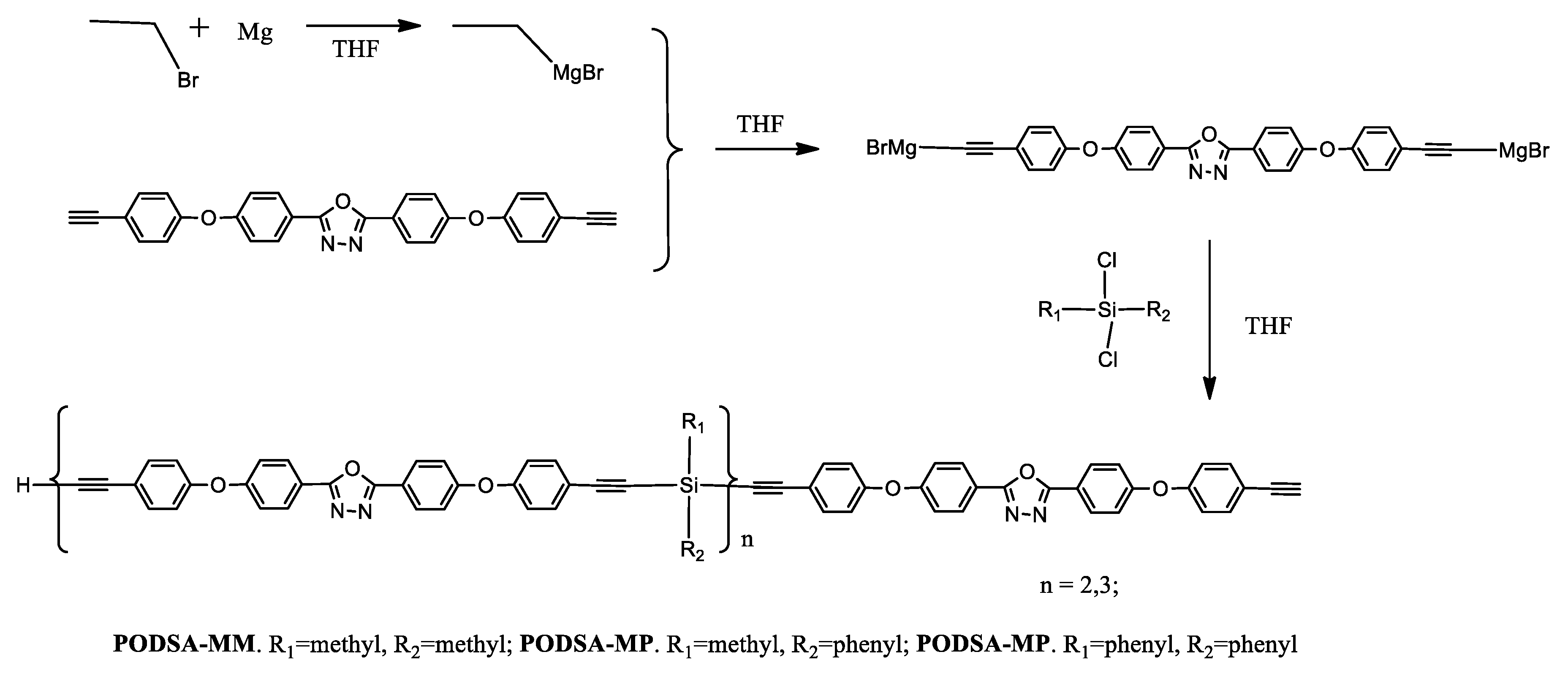

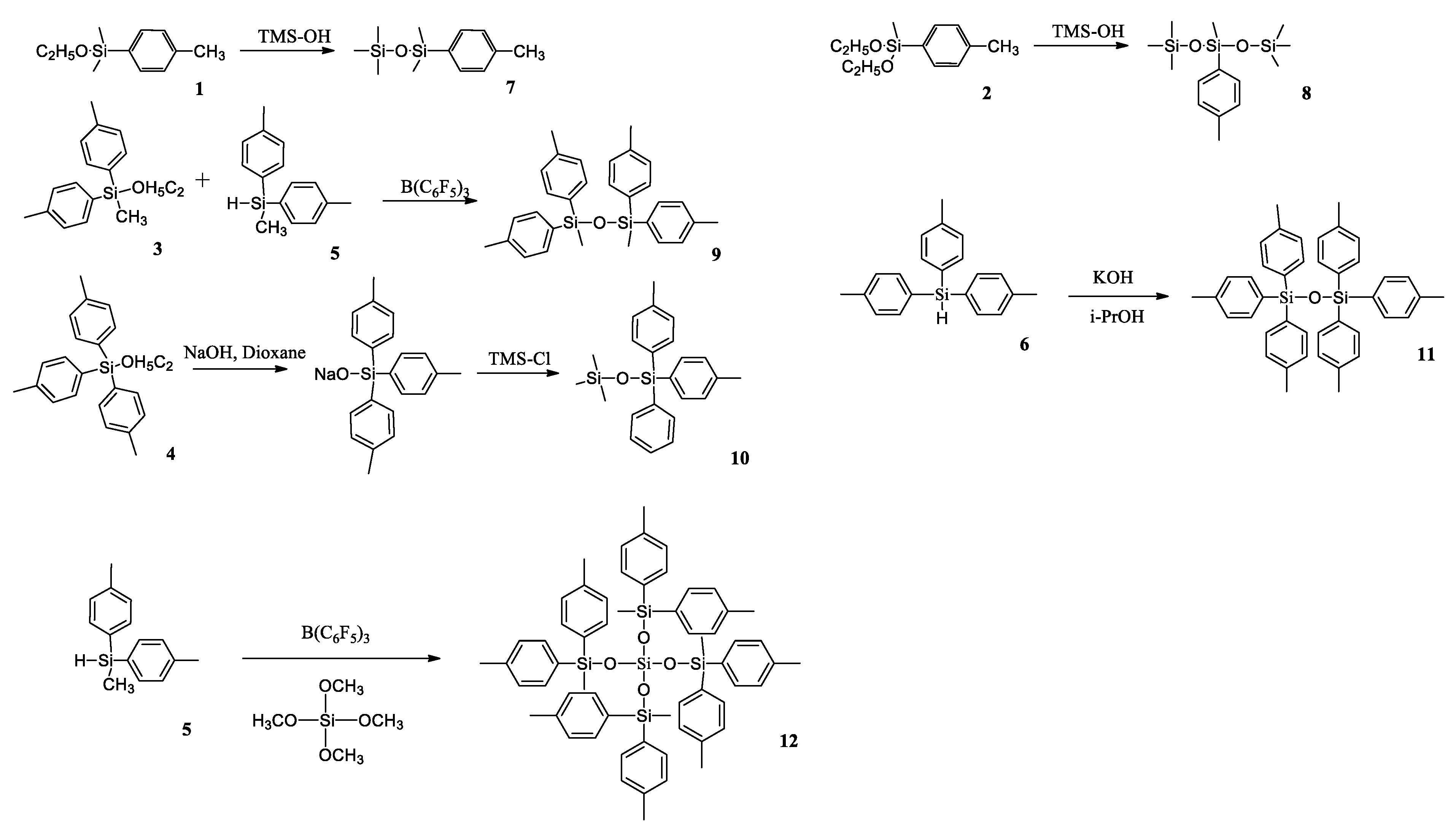
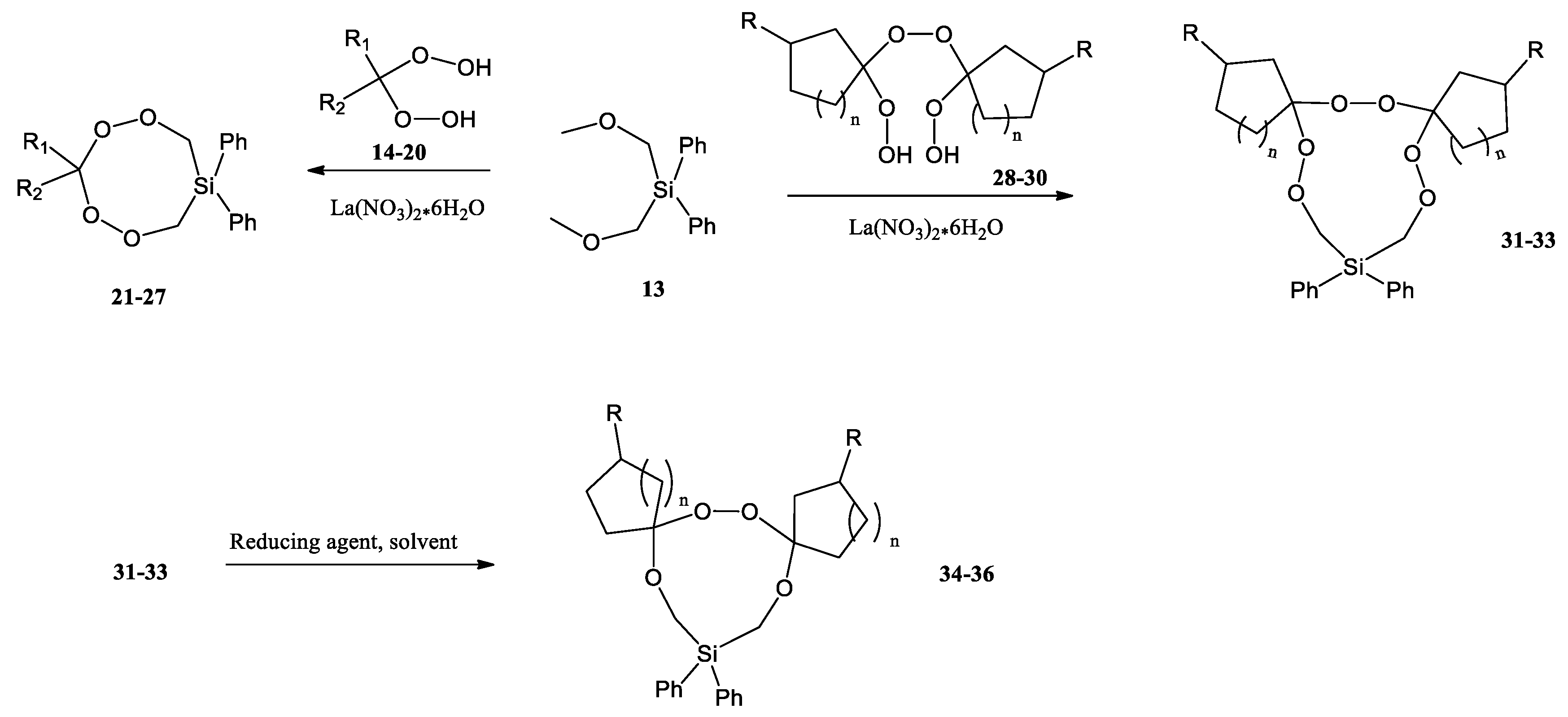
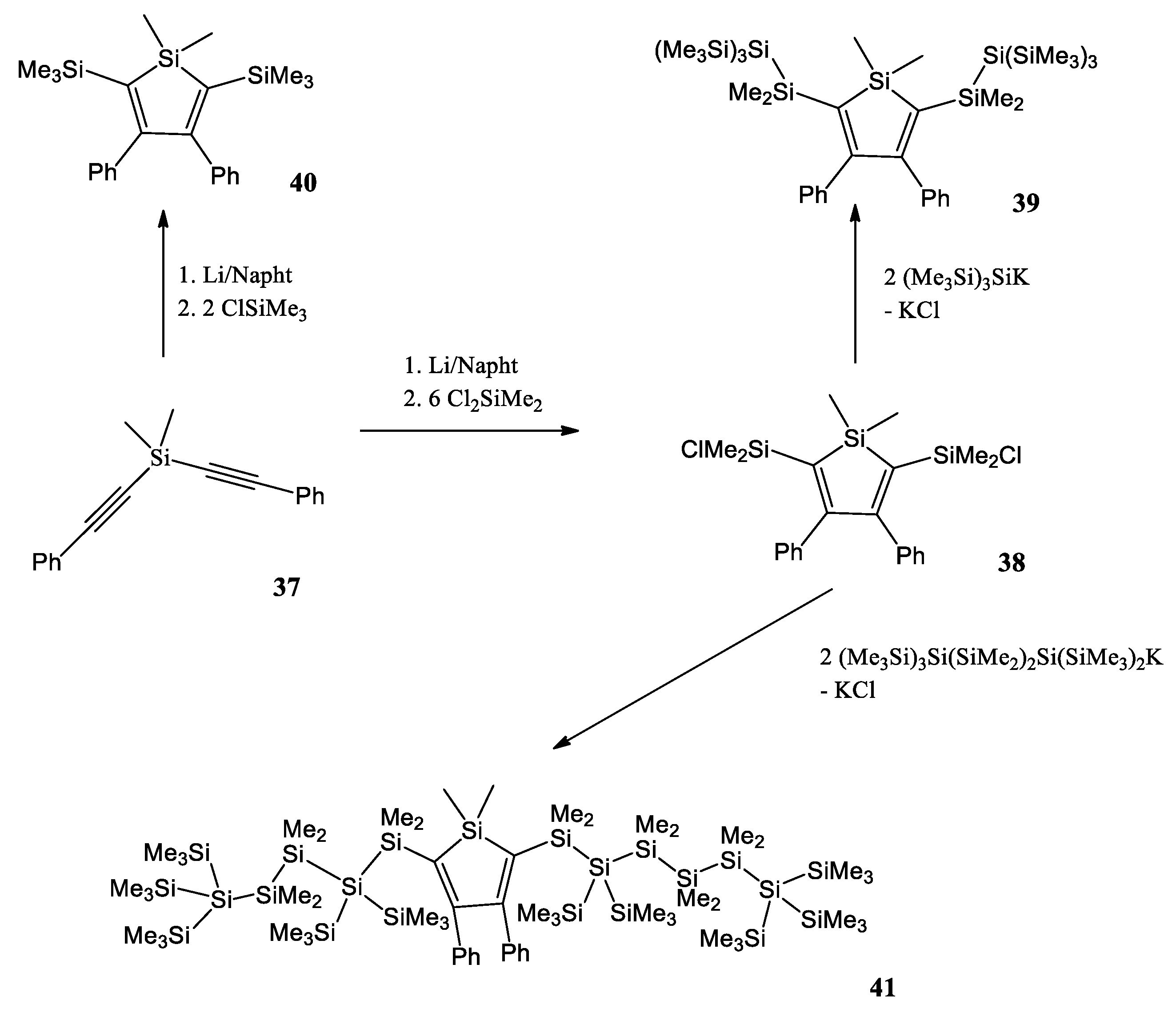



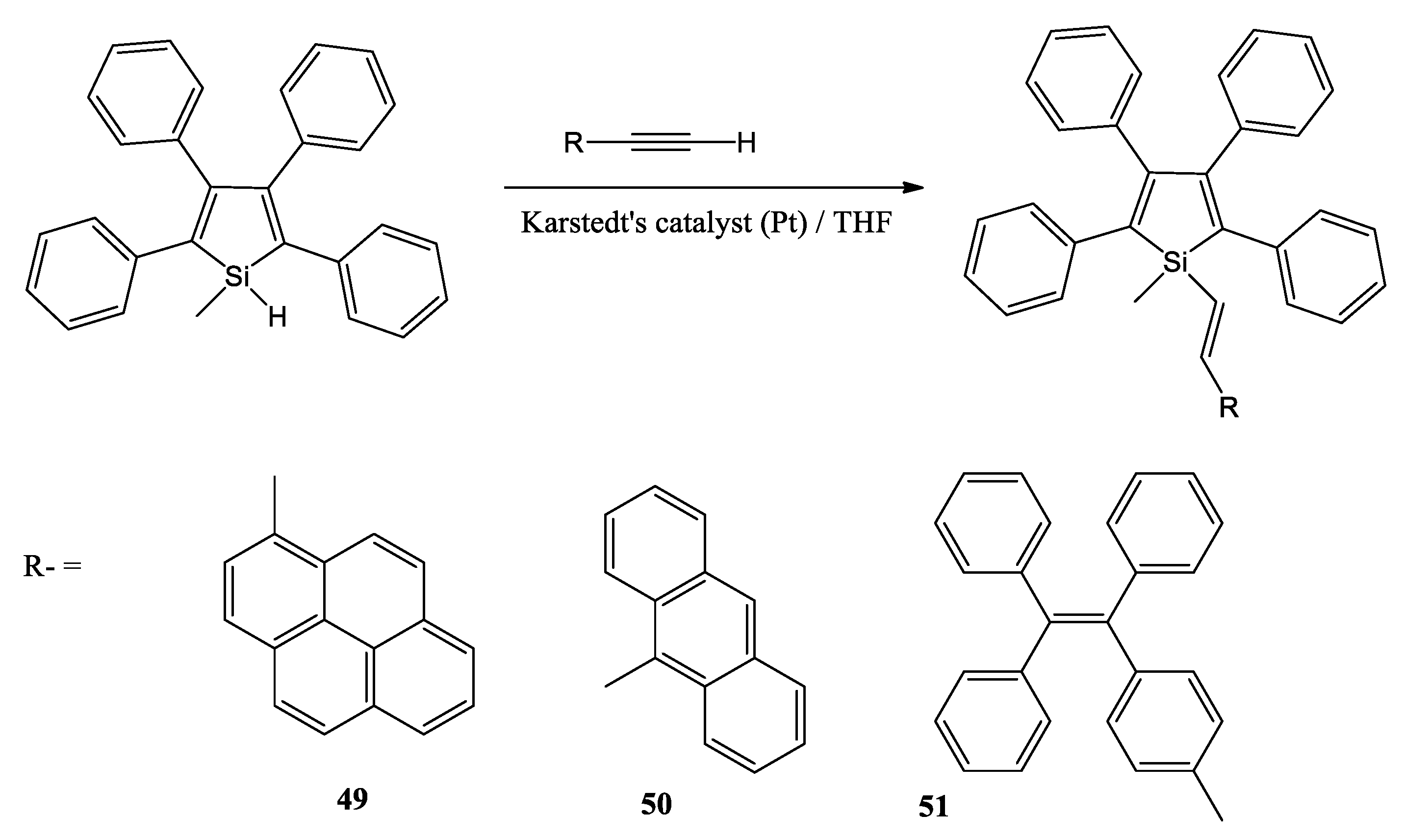

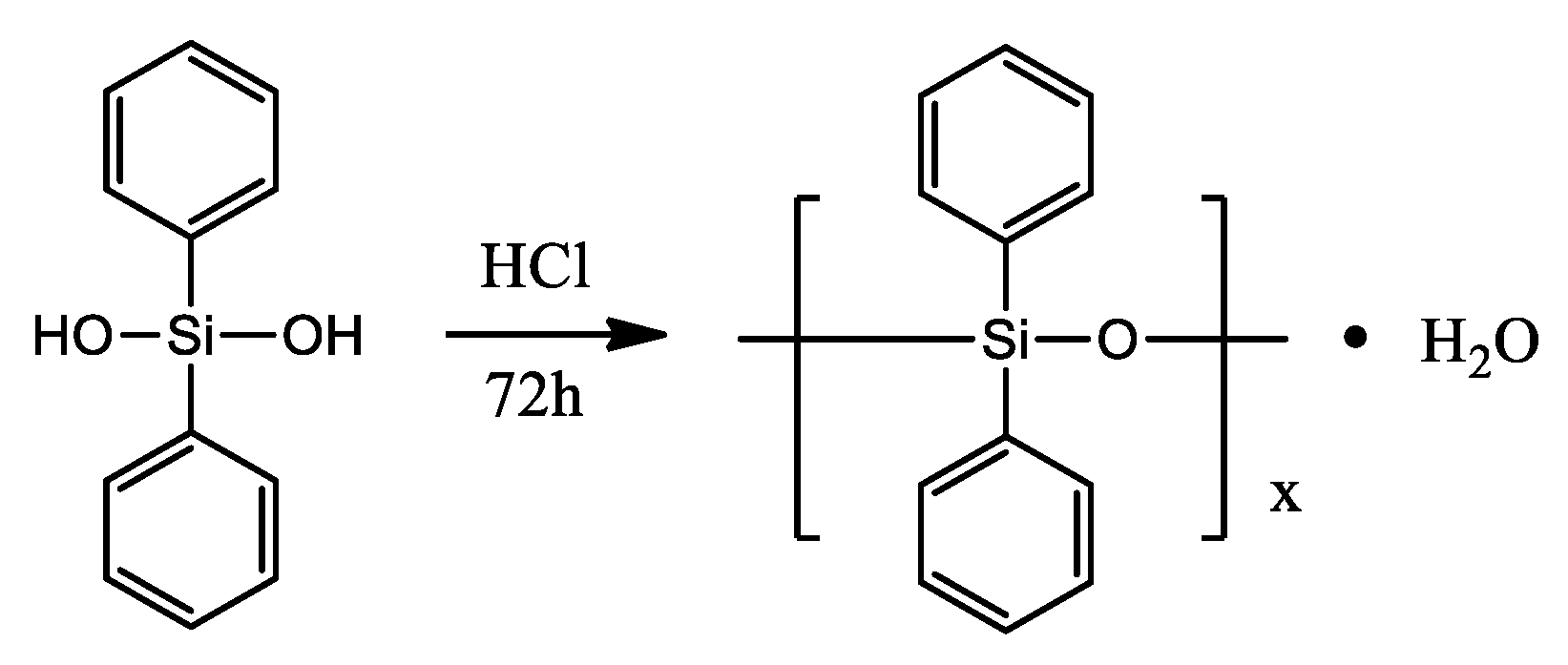

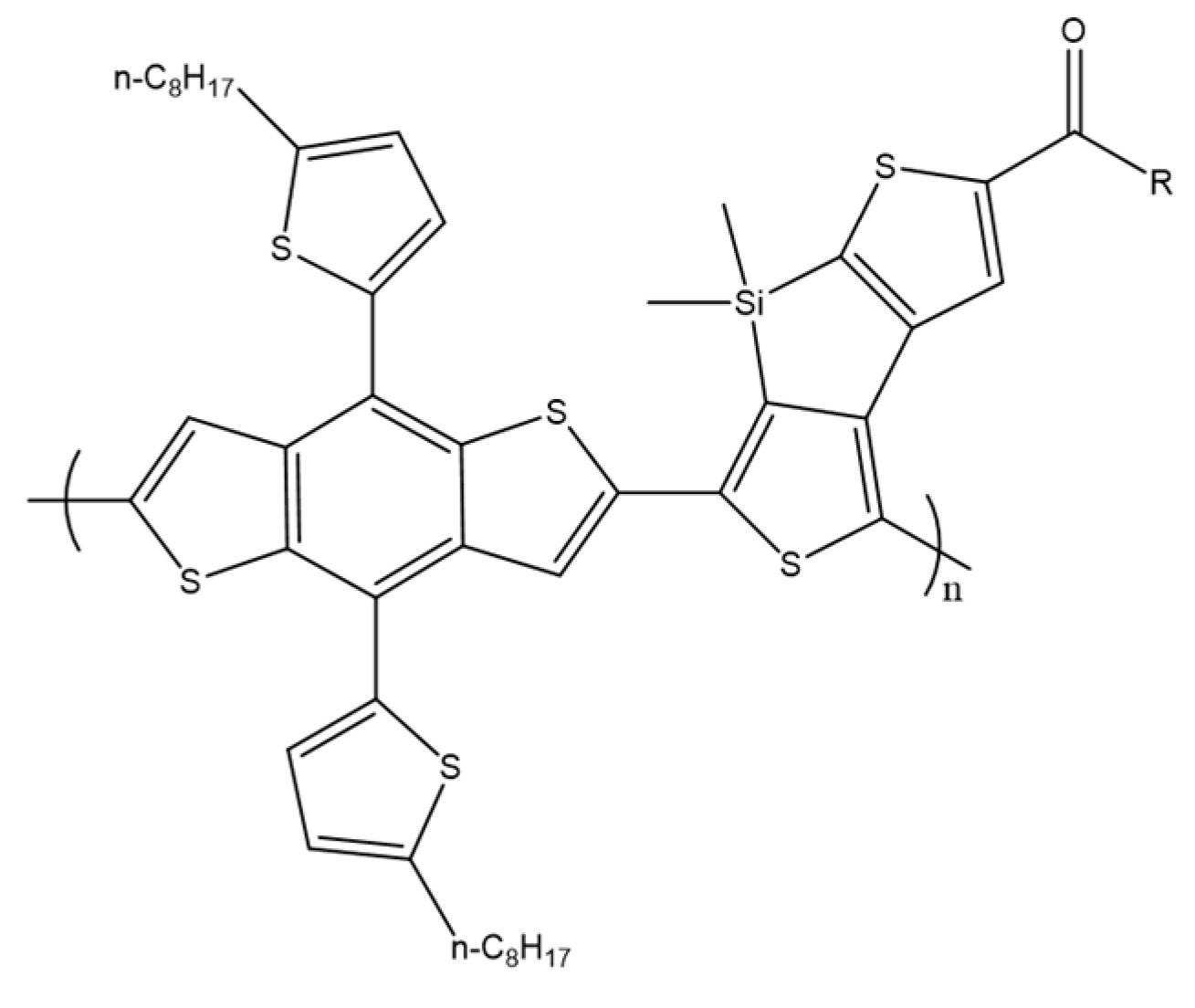

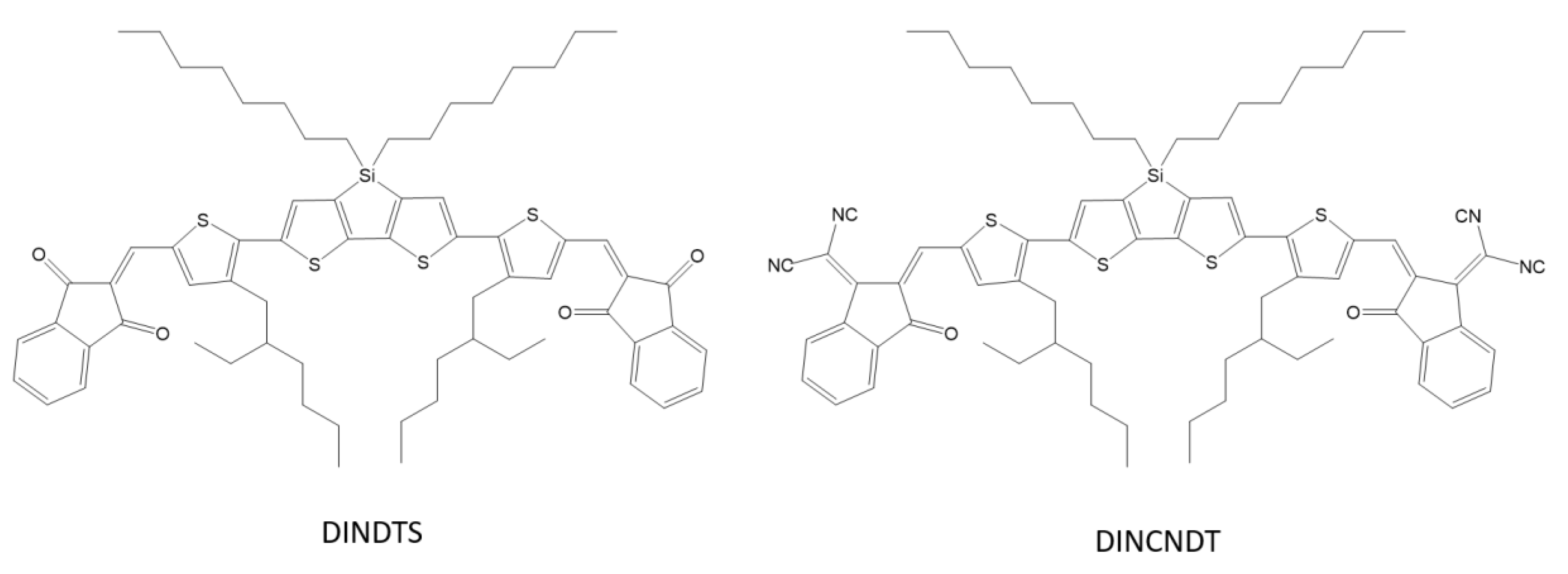



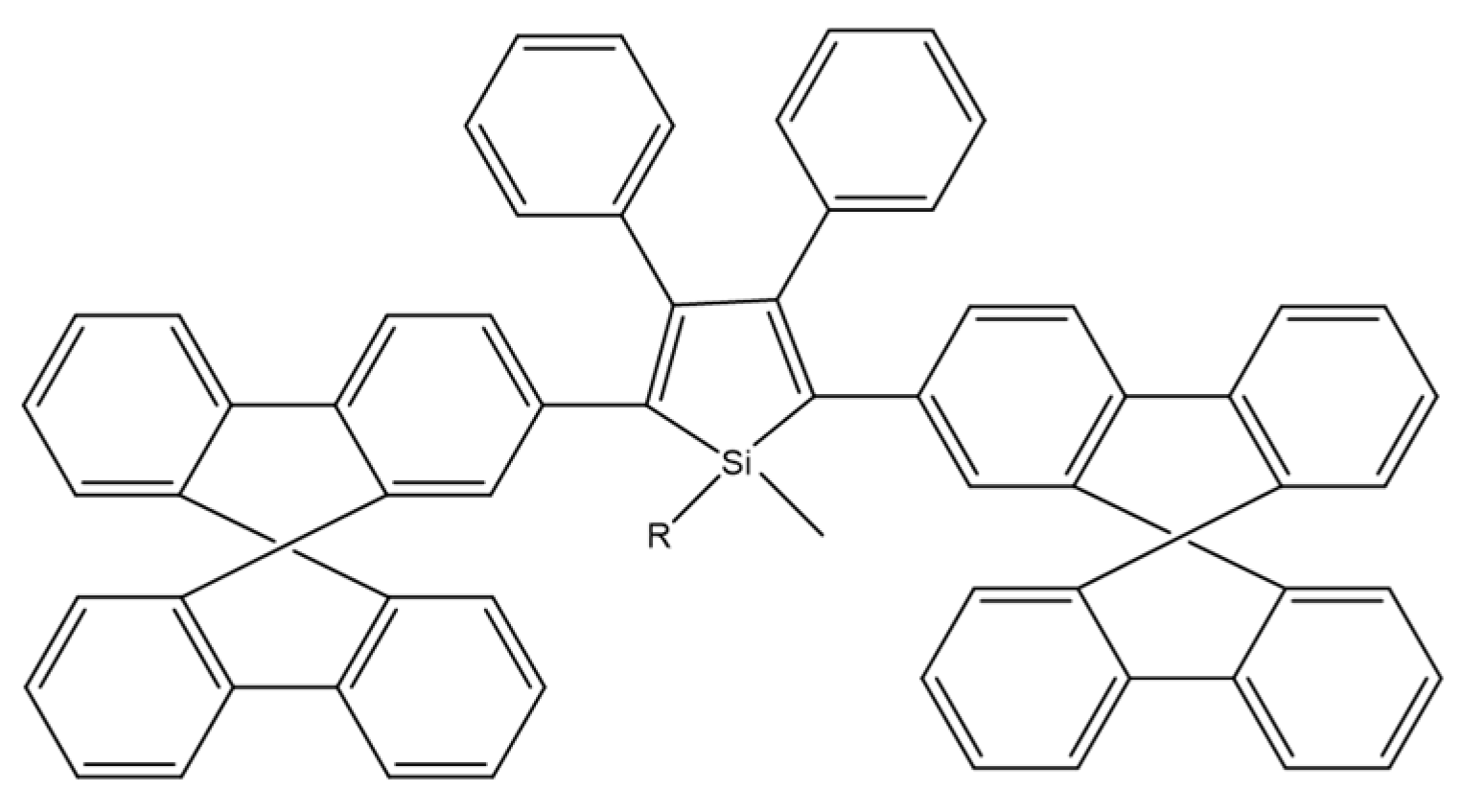
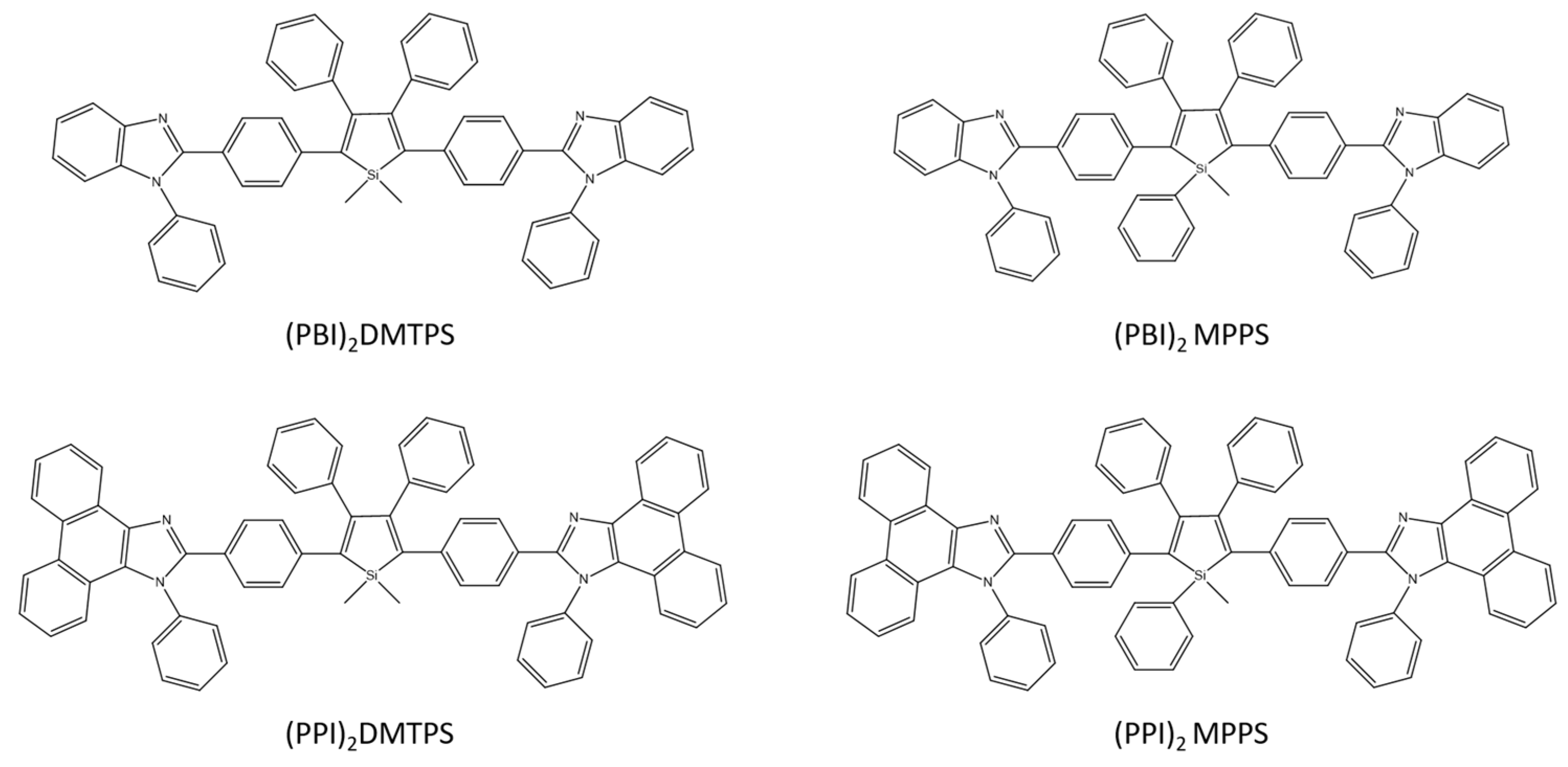


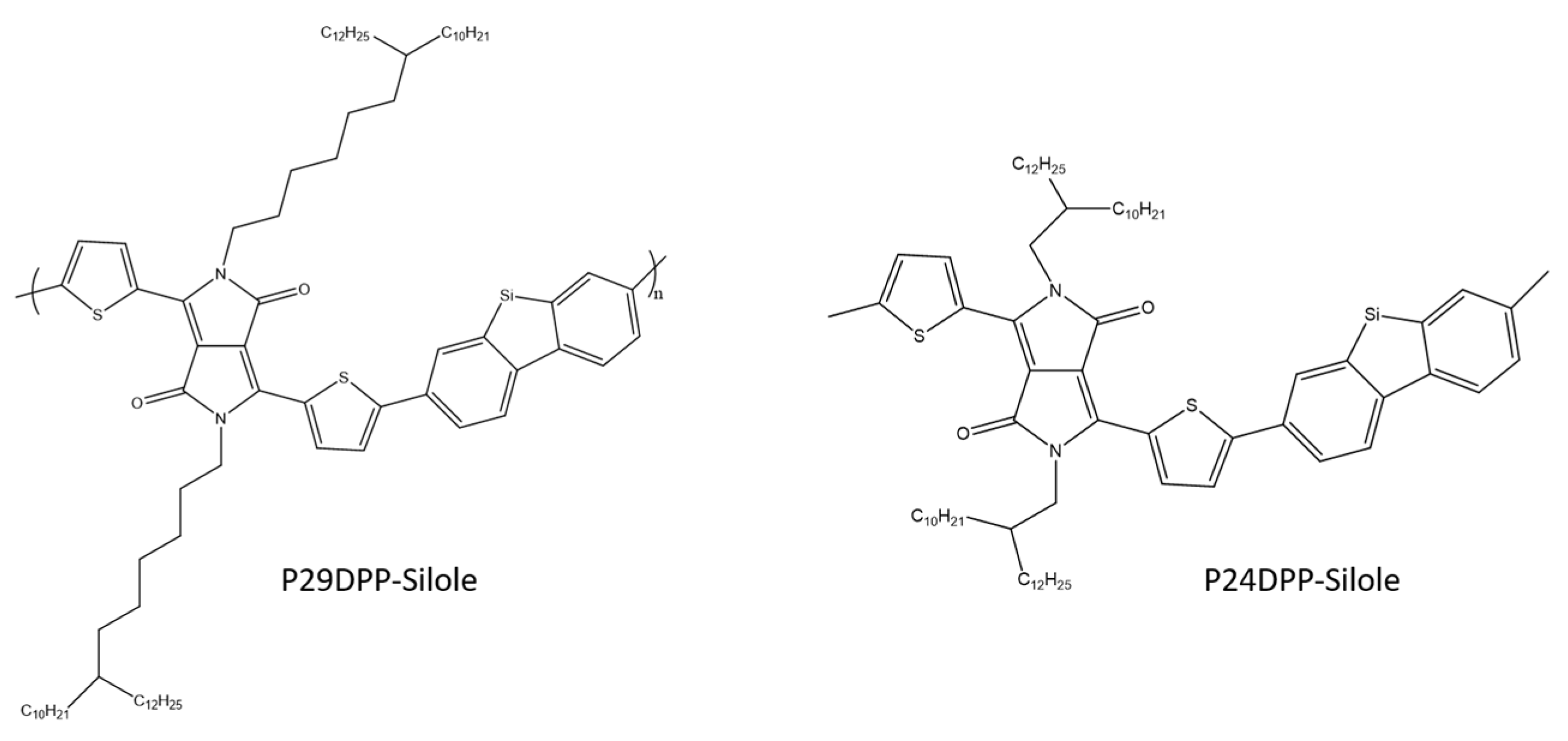


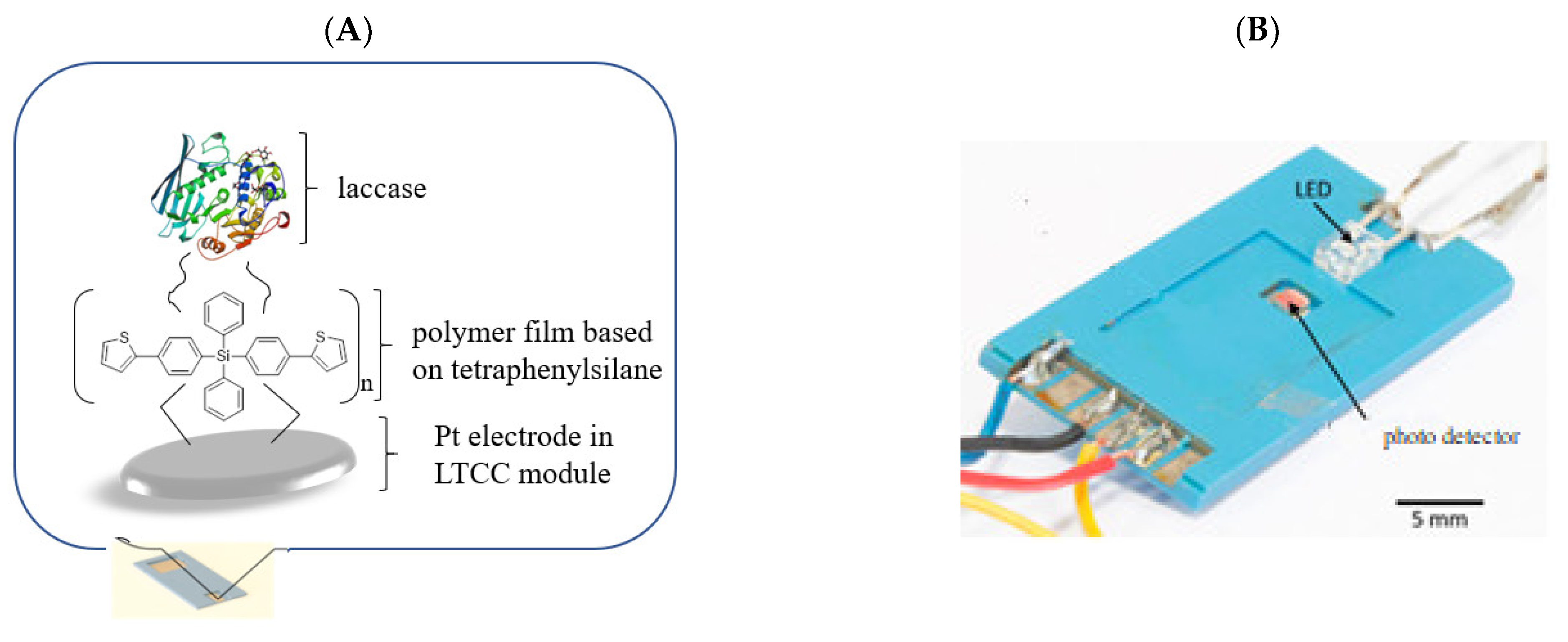
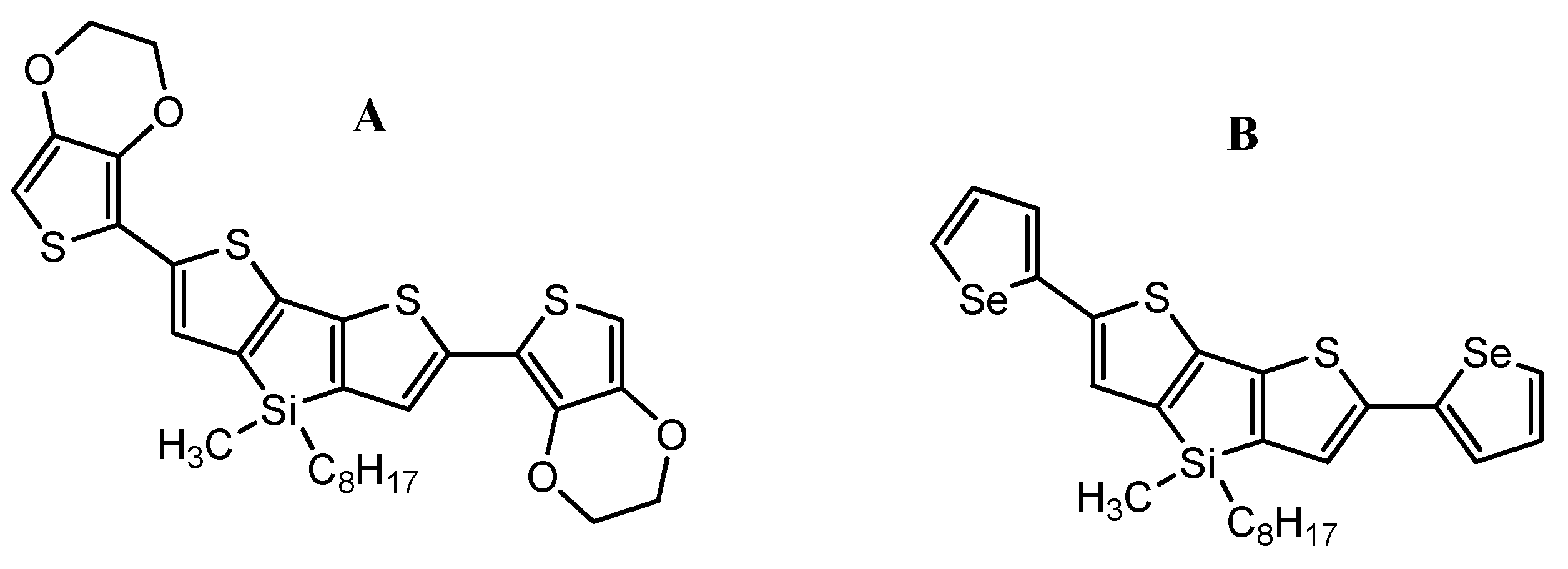
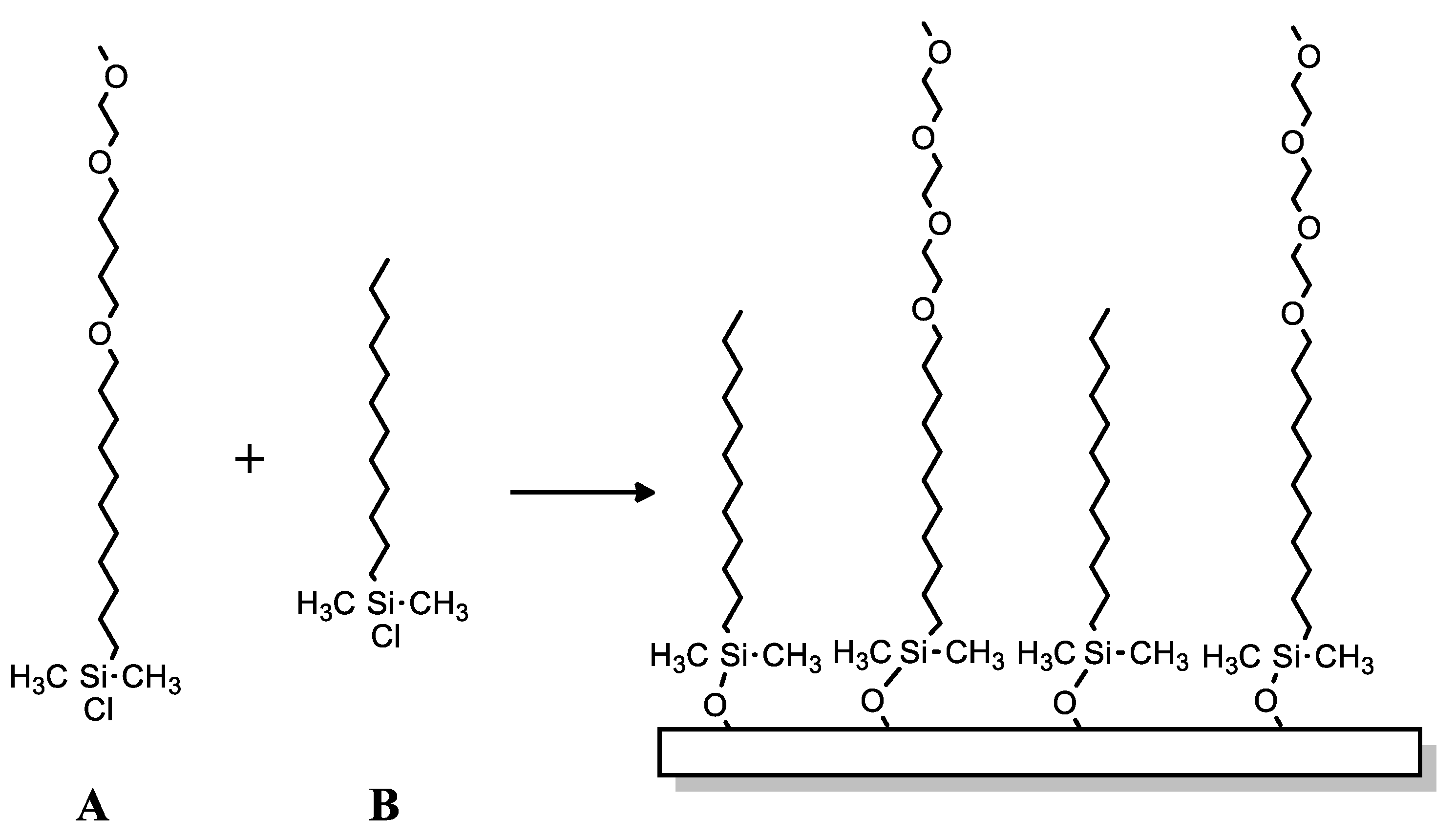
| Donor | Acceptor | Voc (V) | PCE (%) | Ref. |
|---|---|---|---|---|
| DTS | BDT | 1.07 | 3.29 | [57] |
| DINTTDTS/DINDTS | IDT-C8 | 0.89 | 4.52 | [58] |
| dithieno[3,2-b:2′,3′-d]silole | thieno[3,4-c]pyrrole-4,6-dione | 0.63 | 2.65 | [64] |
| dithieno[3,2-b:2′,3′-d]silole | naphtho[2,3-c]thiophene-4,9-dione | 0.90 | 5.21 | [64] |
| DTS | BDT | 1.01 | 2.66 | [67] |
| DTC/DTS | 3-ethyl-rhodanine | 0.82 | 8.0 | [69] |
| DINDTS/DINCNDTS | IN/INCN | 0.94 | 6.79 | [70] |
| OLED | Turn on Voltage (V) | Maximum Luminance (cd m−2) | Current (cd A−1) | Power (lm W−1) | External Efficiencies (%) | Ref. |
|---|---|---|---|---|---|---|
| Carbazole-substituted dithienosiloles | 5.3 | 91,920 | 17.59 | 12.55 | 5.63 | [79] |
| MFMPS | 3.2 | 31,900 | 16.00 | 13.50 | 4.80 | [80] |
| (PBI)2DMTPS | 2.5 | 14,155 | 13.30 | 14.51 | 4.25 | [71] |
| DMTPS-DPA | 3.1 | 13,405 | 8.28 | 7.88 | 2.42 | [81] |
| PyDMS | 3.5 | 49,000 | 9.10 | 7.10 | 3.00 | [82] |
| Compounds | Hole Mobility (cm2 V−1 s−1) | Electron Mobility (cm2 V−1 s−1) | Ref. |
|---|---|---|---|
| DPP and silole derivatives | 0.49 | 0.26 | [83] |
| DPP and silole derivatives | 0.10 | 0.20 | [86] |
| PDSSDPP | 2.47 × 10−2 | [89] | |
| Si1TDPP | 3.7 × 10−3 | 5.1 × 10−4 | [90] |
Publisher’s Note: MDPI stays neutral with regard to jurisdictional claims in published maps and institutional affiliations. |
© 2021 by the authors. Licensee MDPI, Basel, Switzerland. This article is an open access article distributed under the terms and conditions of the Creative Commons Attribution (CC BY) license (https://creativecommons.org/licenses/by/4.0/).
Share and Cite
Sołoducho, J.; Zając, D.; Spychalska, K.; Baluta, S.; Cabaj, J. Conducting Silicone-Based Polymers and Their Application. Molecules 2021, 26, 2012. https://doi.org/10.3390/molecules26072012
Sołoducho J, Zając D, Spychalska K, Baluta S, Cabaj J. Conducting Silicone-Based Polymers and Their Application. Molecules. 2021; 26(7):2012. https://doi.org/10.3390/molecules26072012
Chicago/Turabian StyleSołoducho, Jadwiga, Dorota Zając, Kamila Spychalska, Sylwia Baluta, and Joanna Cabaj. 2021. "Conducting Silicone-Based Polymers and Their Application" Molecules 26, no. 7: 2012. https://doi.org/10.3390/molecules26072012
APA StyleSołoducho, J., Zając, D., Spychalska, K., Baluta, S., & Cabaj, J. (2021). Conducting Silicone-Based Polymers and Their Application. Molecules, 26(7), 2012. https://doi.org/10.3390/molecules26072012







